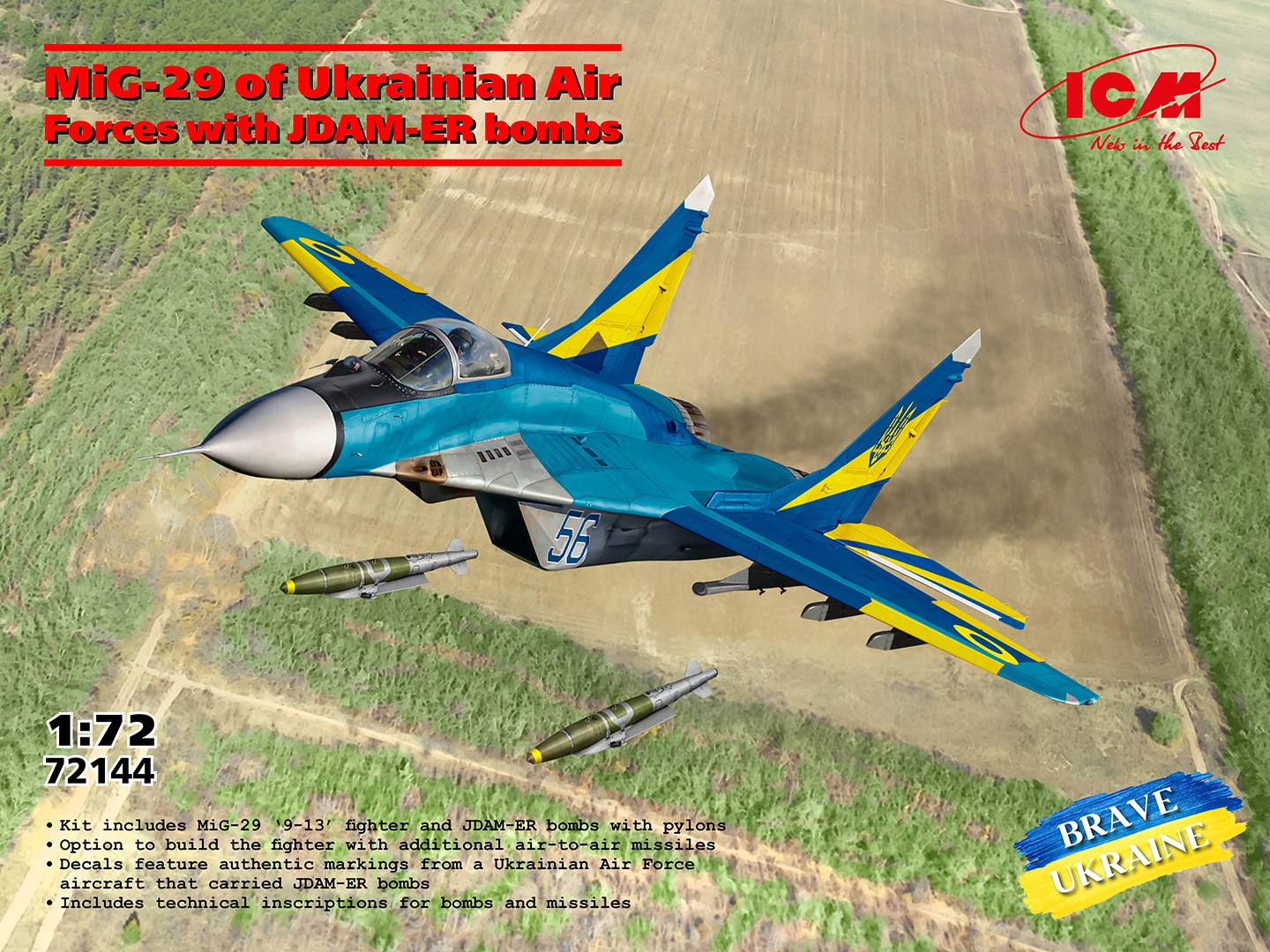MiG-29 of Ukrainian Air Forces with JDAM-ER bombs
From the ICM website,
Soviet-made aircraft from Ukraine’s military aviation fleet have undergone special modifications to integrate Western weapons systems. Specifically, some Ukrainian MiG-29 fighters were modernized to use JDAM-ER precision-guided glide bombs. Special pylons mounted under the aircraft wings allow each plane to carry two bombs. The JDAM-ER bombs’ range — which can reach 70 kilometers under favorable conditions — depends on the carrier aircraft’s altitude and speed. These bombs strike important targets like bridges or military command posts that lie beyond the reach of standard air-based weapons and ground systems.
Upon opening the cover, there is a reinforced white inner box that does a good job of protecting the kit’s seven gray plastic sprues, clear sprue for the canopy and lights, and decal sheet (I recently heard on the Beyond the Box Art podcast that ICM’s boxes are designed to withstand the rigors of delivery services, and this box definitely meets that standard). This MiG-29 kit dates to ICM’s initial 2008 release, with updated weapons. Three of the sprues show that this a repop (weapons sprues from other ICM MiG-29 kits). Also, three of the sprues (A, B and C) don’t have sprue identifiers or parts numbers. The downloadable instructions are also available separately online (https://icm.com.ua/aviation/mig-29-of-ukrainian-air-forces-with-jdam-er-bombs/). Take care with small pieces (grab handles, etc.) as the plastic is fragile and can break when removed from the sprue gates.
There are minor notes that are identified here by their instruction step:
- Sprue Layout: The sprue layout is for another ICM kit, so pay attention to which parts are used and not used on this kit.
- Step 01: Not shown on the instructions, Decal No. 6 is an instrument panel.
- Step 06: NOTE: Be sure to install part B5 joining the upper and lower fuselages (Step 05 and Part A2). It is virtually impossible to install Part B5 after the fuselage has been assembled. Ask me how I know…
- Steps 07-08: Installation of the internal FOD covers (Parts B22 and B31 into their respective air intakes) is tricky. Study photographs and test fit once the air intakes are assembled and their resulting joint is sanded smooth.
- Steps 11-14: Assembly of the JDAMs and their pylons is straightforward. I recommend keeping the JDAMs separate from the pylon for ease of painting.
- Steps 15-16: Recommend keeping the R-73 (AA-12 Archer) missiles (Parts C1-7) off their pylons (Parts C2-10) until after painting.
- Step 17: Assembly of the main and front landing gear would be easier with better callouts. The painting guide is not helpful as it shows the MiG-29 in flight.
As ICM has released several MiG-29 kits since 2008, there are lots of options for various weapon load outs included in this boxing. Load outs include AGM-88 HARM missiles, Vympel R-27 Alamo Medium Range Anti-Aircraft Missile, and various fuel tanks. Check your references and have fun.
This kit has one marking option of a Ukrainian MiG-29 in a special high-visibility paint scheme. While the livery is inspired by the now defunct Ukrainian Falcon’s demonstration team, it is a unique, brightly colored scheme designed to raise the morale of the Ukrainian forces.
I painted the MiG-29 per the instructions. The paint scheme is not overly complex, but a lot of masking and measuring is required to get the lines correct. There is no really easy way to mask, and if there are shortcuts, I would like to know them. Painting started with the ICM paints per the instructions using Sky Grey, then Deep Yellow, followed by Deep Sky Blue (per the instructions, it was a 50-50 mix, so I substituted a craft store acrylic paint), and finally Dark Blue. The details were picked out with their respective colors after the other bright colors were laid down. The ordnance was painted in their called-out colors. For painting, I strongly recommend keeping the weapon pylons off as it will make this task so much easier.
The decals are delicate and conform well to the model, have no silvering and really look the part. Care must be taken due to their small size and fragility as a few wanted to curl back on themselves.
A few things to make this kit easier would be to include masks or a scale-size painting guide to make the lines clean and correct in shape. Also, no pilot figure is included, which makes it hard to represent an in-flight model.
ICM has once again taken an older kit mold, updated it, and made it relevant with the added bonuses of additional weapon payloads. The Ukrainian markings on this high visibility paint scheme really pop. I mounted the MiG-29 on ICM’s suitable PAG-14 airfield plates (reviewed earlier and by Pablo Bauleo).
If you want a unique MiG-29, and don’t mind complex masking, this kit is for you and comes highly recommended.
Slava Ukraini!
Profuse thanks to ICM and the IPMS/USA for providing the review sample.











Comments
Add new comment
This site is protected by reCAPTCHA and the Google Privacy Policy and Terms of Service apply.
Similar Reviews